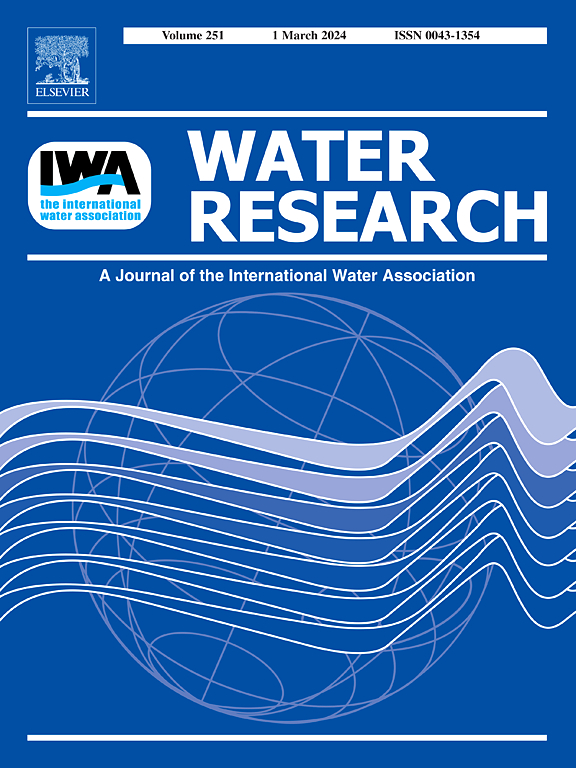Short-chain per/polyfluoroalkyl substances alternatives enhance horizontal gene transfer risks in nitrification systems under quaternary ammonium compounds antimicrobials co-stress despite lower acute toxicity than perfluorooctanoic acid
IF 12.4
1区 环境科学与生态学
Q1 ENGINEERING, ENVIRONMENTAL
引用次数: 0
Abstract
The ecological risks posed by per/polyfluoroalkyl substances (PFAS) and quaternary ammonium compounds (QACs), as emerging contaminants, to the aquatic environment have recently attracted considerable attention. However, it is still unclear whether and how the combined stress of PFAS and QACs affects wastewater treatment system performance and modulates the transmission of resistance genes (RGs). In this paper, it was investigated that the ecological impacts of perfluorooctanoic acid (PFOA) and its alternatives, perfluorobutanesulfonic acid (PFBS) and perfluorohexanoic acid (PFHxA), on nitrification systems with/without diallyl dimethylammonium chloride (DADMAC), a typical QACs disinfectant, during 120 days. Results showed that 3 mg/L PFOA significantly reduced ammonia removal efficiency, while 0–3 mg/L PFBS and PFHxA had no significant impacts. Interestingly, the addition of 0.3 mg/L DADMAC mitigated the inhibitory effect of PFOA on ammonia oxidation and elevated the abundance of complete ammonia oxidizers amoA and ammonia-oxidizing bacteria amoA genes by 15.8 %-52.9 % and 45.0 %-113.9 %, respectively, through looser protein structures of extracellular polymeric substances and more RGs activated. Under single stress, the abundance of total RGs exhibited first decreasing and then increasing trends with increasing concentrations of all three PFAS, and 3 mg/L PFOA enriched the highest. Under combined stress, PFOA led to the highest abundance of RGs by adding 0.3 mg/L DADMAC, while PFBS resulted in the highest abundance of RGs by adding 3 mg/L DADMAC. Notably, the system with PFBS was observed to have the highest abundance of mobile genetic elements (MGEs), followed by PFHxA, particularly inducing intracellular MGEs in sludge to maintain richness and continuity during combined stress stages. Moreover, MGEs were found to have the most positive contribution to the multiplication of antibiotic resistance genes in all three systems. Overall, although PFBS and PFHxA are regarded as typical alternatives to PFOA and are significantly less toxic to the nitrification systems compared with PFOA, both alternatives resulted in higher levels of MGEs, especially posing a more severe risk of horizontal gene transfer in the combined stress environment. Thus, this requires a focus on the RGs transmission risks of using PFAS and its alternatives in disinfectant-intensive environments.


短链/多氟烷基物质替代品增加了季氨化合物抗菌剂共应激下硝化系统中的水平基因转移风险,尽管急性毒性低于全氟辛酸
全氟/多氟烷基物质(PFAS)和季氨化合物(QACs)作为新兴污染物对水生环境构成的生态风险最近引起了相当大的关注。然而,目前尚不清楚PFAS和QACs的联合压力是否以及如何影响废水处理系统的性能并调节抗性基因(RGs)的传播。研究了全氟辛酸(PFOA)及其替代品全氟丁烷磺酸(PFBS)和全氟己酸(PFHxA)对含/不含典型QACs消毒剂二烯丙基二甲基氯化铵(DADMAC)硝化系统120 d的生态影响。结果表明,3 mg/L PFOA显著降低氨氮去除率,0 ~ 3 mg/L PFBS和PFHxA对氨氮去除率无显著影响。有趣的是,添加0.3 mg/L DADMAC后,PFOA对氨氧化的抑制作用减弱,完全氨氧化剂amoA和氨氧化细菌amoA基因的丰度分别提高了15.8% ~ 52.9%和45.0% ~ 113.9%,这是通过细胞外聚合物质(EPS)的蛋白结构更疏松和RGs被激活来实现的。在单一胁迫下,总RGs丰度随3种PFAS浓度的增加呈现先降低后升高的趋势,其中以3 mg/L PFOA富集最高。复合胁迫下,PFOA添加0.3 mg/L DADMAC时RGs丰度最高,PFBS添加3 mg/L DADMAC时RGs丰度最高。值得注意的是,有PFBS的系统具有最高的移动遗传元件(MGEs)丰度,其次是PFHxA,特别是在污泥中诱导细胞内的MGEs,以在联合胁迫阶段保持丰富度和连续性。此外,在所有三种系统中,发现MGEs对抗生素抗性基因的增殖有最积极的贡献。总体而言,尽管PFBS和PFHxA被认为是PFOA的典型替代品,并且与PFOA相比,它们对硝化系统的毒性要小得多,但这两种替代品都会导致更高水平的MGEs,特别是在复合应激环境中造成更严重的水平基因转移风险。因此,这需要关注在消毒剂密集的环境中使用PFAS及其替代品的RGs传播风险。
本文章由计算机程序翻译,如有差异,请以英文原文为准。
求助全文
约1分钟内获得全文
求助全文
来源期刊

Water Research
环境科学-工程:环境
CiteScore
20.80
自引率
9.40%
发文量
1307
审稿时长
38 days
期刊介绍:
Water Research, along with its open access companion journal Water Research X, serves as a platform for publishing original research papers covering various aspects of the science and technology related to the anthropogenic water cycle, water quality, and its management worldwide. The audience targeted by the journal comprises biologists, chemical engineers, chemists, civil engineers, environmental engineers, limnologists, and microbiologists. The scope of the journal include:
•Treatment processes for water and wastewaters (municipal, agricultural, industrial, and on-site treatment), including resource recovery and residuals management;
•Urban hydrology including sewer systems, stormwater management, and green infrastructure;
•Drinking water treatment and distribution;
•Potable and non-potable water reuse;
•Sanitation, public health, and risk assessment;
•Anaerobic digestion, solid and hazardous waste management, including source characterization and the effects and control of leachates and gaseous emissions;
•Contaminants (chemical, microbial, anthropogenic particles such as nanoparticles or microplastics) and related water quality sensing, monitoring, fate, and assessment;
•Anthropogenic impacts on inland, tidal, coastal and urban waters, focusing on surface and ground waters, and point and non-point sources of pollution;
•Environmental restoration, linked to surface water, groundwater and groundwater remediation;
•Analysis of the interfaces between sediments and water, and between water and atmosphere, focusing specifically on anthropogenic impacts;
•Mathematical modelling, systems analysis, machine learning, and beneficial use of big data related to the anthropogenic water cycle;
•Socio-economic, policy, and regulations studies.
 求助内容:
求助内容: 应助结果提醒方式:
应助结果提醒方式:


